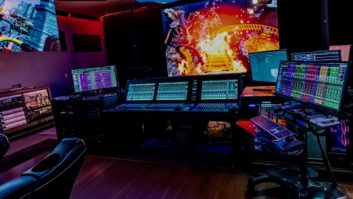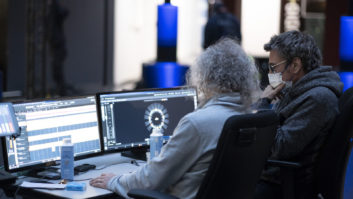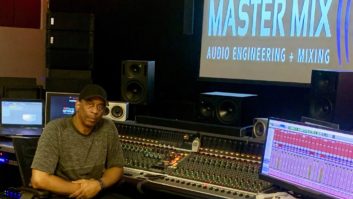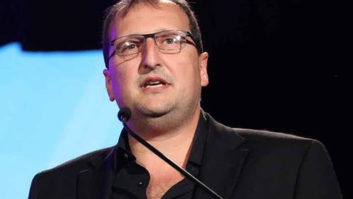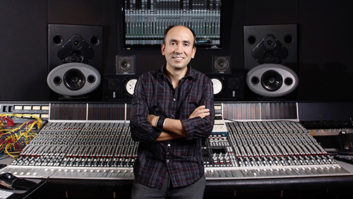Looking back two decades ago to the launch of the Compact Disc, it’s easy to forget how iffy the carrier’s prospects were in its first few years. Players were too expensive for anyone other than “early adopters,” and labels — smarting from a post-disco implosion — weren’t ready to spend much on production for a format whose sales appeal was still unknown. In that climate, many CD masters — particularly for catalog releases — were simply transferred from EQ masters that were made during mastering sessions for LPs. Reflecting mastering engineers’ responses to the characteristics and limitations of an entirely different playback medium, the sound of these early releases often falls short of the CD’s potential.
When DVD-Video came along, many of the same factors came into play. In the DVD scenario, the role played by the EQ master in the record industry was filled, instead, by the theatrical print master. Often, the culmination of weeks or months of work, it embodies the production team’s judgment of how a film should sound when exhibited in a theater. At first, it seemed safe to assume that DVD, given its digital audio capabilities, could adequately convey this sound to the home-theater viewer. So, once again, a source optimized for one medium was often transferred straight across to provide audio for another. And, once again, this expedient proved less than fully satisfactory, this time because the theatrical and home-theater listening environments are such different worlds.
With DVD now firmly established, it’s become increasingly common for films to undergo a separate remix to optimize the sound for home-theater playback. “If the job is done well,” says Jerry Steckling, acoustic engineer at Skywalker Sound in Marin County, Calif., “the sound translates to the home-theater environment as well as it does to the big theatrical environment. The filmmaker sat down and said, ‘That’s my movie,’ on those big theatrical speakers, so the whole job in making the DVD is to try to give that experience on small speakers.”
Home-theater systems, however, are not only different from theatrical sound systems but also far more varied. That can make it difficult for film mixers to tailor their remixes for DVD with the same level of confidence that they are used to from their theatrical work. What’s needed, Steckling says, is “a more formal industry standard for mixing DVD. We’re not that far apart from exhibition cinema standards, or even from music and computer game mixing environments. With small pushes and shoves we could all be on the very same page.”
APPLES AND ORANGES
The starting point when optimizing sound for any delivery platform is the question: “What’s it going to be played back on?” When the target listening environment is home theater, that’s not an easy question to answer. “There’s a big rainbow of things going on,” says Brian Vessa, technical audio supervisor in the Post Production Services department of Sony Pictures Entertainment in Culver City, Calif. “Some people just took their hi-fi speakers and then built out from there. Other people went the opposite direction and went to Good Guys and bought the little tiny speakers all around or a Bose system. You’ve got apples and oranges there. There’s no standard in home theater.”
Of course, THX has established a standard through its certification programs, but the reality is that there is still a very broad cross-section of systems out in the field. That puts technical staff, Vessa says, in the position of “trying to get to a common denominator that will translate on one side or the other of what we have set up on the mixing stage. It has to work both for systems that tend to be more warm and boomy and systems that tend to be thin and bright, both of which you find in the home.”
Compounding the issue of speaker response is the fact that the speakers are so much closer in the home than in a theater. “When you bring something into your home and you hear it on near-field speakers, you immediately get different sensations out of the sound,” Vessa says. He also points out that the screen itself affects the sound in a theatrical environment. So a crucial part of setting up the mix is “getting the speakers out from behind the screen and up-close: Appreciating what’s really coming out of the speakers, as opposed to what it’s sounding like from a distance behind a screen — that’s a lot of it right there.”
Even with near-field monitors arrayed up close, substantial questions remain regarding how best to calibrate the system for a home-theater mix, including both high- and low-end response. In large part, that’s because theatrical playback systems are set up to the “X-curve,” a response curve defined in ISO 2969 and SMPTE 202M. “On the top end,” Steckling says, “the X-curve starts at 2 kHz and is attenuated 3 dB per octave going up the spectrum. So when you’re tuning for a big theatrical mix, your display should show 3 dB per octave going down in a nice line from 2 kHz. There’s an X-curve for the bottom side, as well: 3 dB per octave going down from 63 Hz.”
While the frequency response of home-theater speakers is all over the map, it’s rarely as attenuated on the high end as the X-curve. So a mix made to sound good on an X-curve playback system — in theaters and dubbing stages — is unlikely to sound the same on a home-theater setup. “It can be really bright in somebody’s home,” Vessa says. “And we’re not talking about that nice, silky high end that’s way out there; we’re talking about something in the harsh register, 4 to 8 kHz. Dialog can be in there; sibilances can be in there; and effects, especially metallic-type effects, can trash your ears in there.”
Because of the closeness and brightness, playback of an X-curve mix through a home-theater system also tends to reveal imperfections that were not noticeable on an X-curve system. “You hear all kinds of things that no one ever heard from the speakers in the theaters,” Vessa says. “Punch-ins, for example, and also distortion. There’s a tendency for people in the theatrical environment to push a lot of level. They got used to the way mag forgave that to some extent with kind of a soft compression. In today’s world of digital recording, there is a finite ceiling past which the results are unpredictable and vary on different playback systems. In a theatrical environment, these ‘overs’ are not noticed or they are forgiven. But we have found that when you put those same levels onto DVD and hear it near-field, it’s not forgiven.”
BASS-MANAGEMENT LOWDOWN
Another potential problem in working with theatrical tracks for DVD is undesirable low-end activity, because of differences in the way the two environments handle low end. In multichannel theatrical systems, the sound reproduced by the subwoofer comes exclusively from the Low-Frequency Effects (LFE) track, meaning that the sounds have all been explicitly assigned to the sub during the mix. At the same time, says Steckling, “the frequency response on a typical theater system drops off like a rock at about 40 Hz, sometimes as high as 45, 46, 47 Hz. So when a film is mixed, there is easily information below 40 Hz that was not heard on the mixing stage and you don’t hear it in the theaters. Nobody has heard what’s down there below 40 Hz in the screen channels.”
Home-theater systems, meanwhile, use “bass management,” in which low-frequency sounds (typically below 80 Hz) from the front and surround channels are “crossed-over” and routed to the sub, where they are mixed with the LFE channel. The idea is to prevent these signals from overloading small limited-range satellite speakers and instead direct them to a transducer capable of low-frequency reproduction. But Vessa says that the results can be unexpected: “If you’ve got front-channel information on the print master in that 20 to 40Hz band, in a bass-management system, that will get redirected to the subwoofer. You’ve never heard it before, but now it’s coming out in the sub, which already has everything that was steered directly to the LFE channel. You may be very surprised at some of the buildup that you get down there; all of a sudden, the sub’s really talking.”
One fix, Steckling says, is to filter the energy below 40 Hz on the theatrical print master except in the LFE channel. “That way, if the theatrical mix will translate better to the DVD, you’re not going to get real surprised with all of this stuff under 40 Hz suddenly popping out.” Vessa advocates a different approach, based on the fact that not everybody has a subwoofer or has bass management engaged. “Initially, I’ll do my printing without listening to bass management,” he says. “Then I do an entire playback with the bass management on, and I make notes. If anything is popping out that shouldn’t be, we’ll go back in and catch it on a fix pass.”
However you handle it, Vessa says, “you have to be very careful about the low end.” Not only can unintended low-end activity be distracting, but it can also throw off the mix’s spectral balance, reducing intelligibility. “If you put too much in the sub or too much is being redirected there, it actually works against the people at home being able to turn it up to a volume where the mixer would like the dialog to be. Low frequencies, as we know, travel out, back, through surfaces and everything else. The subwoofer is the first thing that’s going to get the neighbors coming after you to turn down the system.”
DVD ON THE STAGE
Given all of the unwelcome consequences, it’s clear that a simple transfer of the theatrical print master is not the ideal approach to DVD sound. From fairly early in the format’s life, efforts were underway in various quarters to find a better way. One approach has been epitomized by Robert Margouleff and Brant Biles, whose aptly named Mi Casa Studios brings the audio-for-DVD mastering process into an actual home environment. (See “Mi Casa Studios,” Mix, December 2002.) Others — including Don Eklund, who was chief engineer at Sony’s Digital Authoring Center in the early days of DVD — have viewed DVD optimization as a process that takes place on the mixing stage as an extension of a film’s theatrical mix.
Vessa recalls the Men in Black DVD as the first opportunity for Eklund to put his ideas into practice. “A special mix was created to see if they could resolve some of the issues they were noticing with the theatrical print master,” he says. “In doing so, they were able to repair some of the problems and also optimize the soundtrack for the DVD release.”
Vessa says that the approach “started off really simple: ‘Let’s set up some smaller speakers; let’s put it to digital tape instead of mag.’ Then when I started in ’98, Don handed it over to me and said, ‘Run with it.’” The result is a setup specification that has grown into an 18-page document guiding audio master preparation for every Sony Pictures Entertainment film destined for DVD. (See “The Sony Setup,” page 56.) “You keep listening,” he explains, “honing in on something that allows you to say, ‘If I use this environment, it’ll translate.’ That’s really what you’re looking for.”
Vessa’s specification, admittedly, is oriented toward working on a theatrical stage with a near-field monitor setup. Monitor volume is reduced to 80dB SPL “to more closely simulate a realistic home-listening level,” and compatibility is checked on a standard television. The suggested overall mix strategy involves “a moderate reduction in the dynamic range compared to the theatrical presentation…Soft sections are raised, especially music and dialog, but often background effects and soft Foley, as well. Very loud sections may need to be pulled back.” The priority is that “the home listener should not have to continually adjust their volume up and down to hear the detail clearly.”
If the idea is to simulate a home-listening experience, one might wonder about the need for pages of detailed requirements for the components and calibration of the monitors. Why not run down to the nearest electronics superstore and pick up a $300 surround system? “Because then you really don’t trust it,” Vessa says. “You need a good enough system,” Steckling agrees, “to be able to tell the difference between what’s on the track and what’s happening in the monitors. So if something’s distorting, you know it’s on the track.”
“The mixer needs to feel good about the fact that they’re listening to something that’s not totally different from what they’re used to,” Vessa adds. “It’s been hard enough even to get some mixers to just sit down to Genelecs or M&Ks. They’ve just come off of months with a movie at very loud volumes, and everything’s very large. And then, regardless of what the system is, when you go near-field, a lot of them are like, ‘My God, I don’t know quite what to do with this.’ So you’ve got to give them good enough quality that they can start to fiddle and go, ‘Gee, I really do hear that little move I’m making.’ Then they can start really getting inside the speakers and trusting the results.”
This last point underscores the importance both Vessa and Steckling place on engaging a film’s theatrical mixers in the DVD-optimization process. “The director and sound designer are often off to something else,” Steckling says, “and they want to feel that the DVD is in good hands. So they are happier that a mixer from the film — someone they trust and that knows the film — is dealing with the DVD.”
Vessa agrees that if you stay with the same mixer, “you’re going to get a translated product — the experience that the original mixer has with the movie is key to maintaining the integrity of the film’s vision. I know that the mixers from the films that I’ve worked with have certainly appreciated the opportunity to have a listen in this environment to see if they want to do anything to it and to do the tweaks themselves. Sometimes, however, the mixing team is on to another project directly and is not available. But as long as you’ve got the participation of someone else from the production who knows the original intent and sound choices of the film, it doesn’t necessarily have to be the same mixer.” The main point, as he writes in his specification, is that “the end results will translate well to the home environment, where the film will be enjoyed long after the theatrical run.”
Philip De Lancie is Mix’s new-technologies editor.
THE SONY SETUP
Sony Pictures Entertainment’s “SPE Specifications for the Creation of Home Theater Printmasters” covers the creation from theatrical stems of both 5.1 and Lt/Rt (for Pro Logic) print masters that “optimize a film soundtrack for home presentation.” The specifications define requirements and setup for a home-theater remix on a full mixing stage.
In terms of near-field speaker placement, SPE calls for the three front speakers to be set in an arc 7 to 8 feet in front of the mix position, with Left and Right each 3.5 to 4 feet out from Center. The speakers are placed on stands adjusted to 6 to 8 inches above the console meter bridge and angled down toward the mix position. Left and Right Surrounds, meanwhile, are placed 4 to 6 feet behind and to the sides of the mix position at an angle of 110 degrees. The front and surround speakers are each calibrated fo 80 SPL, C-weighted, using a spectrum analyzer. As for the sub, it generally goes in front, but may be positioned as needed to achieve the desired response. Subwoofer calibration is +10 dB higher in its passband, relative to the average spectral balance of the near-fields.
Regarding the speakers employed, SPE’s spec requires Genelec 1031A self-powered speakers and a Genelec 1094A self-powered subwoofer, or similar. The 1031As are to be used with the -2dB roll-off switch engaged on the tweeter only, with all other switches in flat position. “The -2dB switch,” says Sony’s Brian Vessa, “puts a gentle shelf on the top. It doesn’t let the response just go wide open out to the sky, because you would never have that at home.”
Skywalker’s Jerry Steckling agrees. “There’s no such thing as flat,” he says, “except maybe in Nebraska. If there’s a speaker that measures flat at 1 meter in an anechoic chamber, when you set it up at 8 feet in a typical living room with a little absorption and all that sort of stuff, it’s not flat anymore. The -2dB EQ on the Genelecs does a shelf that starts to roll off at about 6 kHz, and we believe that this is what is happening at home. Our own approach is to leave that switch in flat and apply a nice, smooth curve. But we’re within spitting distance of Sony’s spec on actual high-end response. We just arrive there a little bit differently.”
Vessa says that it is “a perfectly reasonable approach” to use quality near-fields other than Genelecs. “I did Final Fantasy through M&Ks,” he says, “and it came out just fine.” He suggests, though, that M&Ks be used without any roll-off because “M&Ks out-of-the-box aren’t as bright as the Genelecs.” As to why he specified Genelecs in SPE’s requirements, he says it’s because of “the detail they give. If there’s something that can be heard — if there’s a bad punch-in, an odd sibilance, a weird panning, anything like that — you’re really going to hear it. Because everything’s very detailed and very image-oriented in those speakers.”
— Philip De Lancie
DVD REMIX AT ZAENTZ
“We definitely believe that it is essential to remix films for the DVD release,” says Jim Austin, chief engineer at Saul Zaentz Film Center in Berkeley, Calif. “It’s not a major remix, but when the changes are done properly, the result really allows the film to play properly in the home environment.”
Austin describes four main reasons why DVD releases can typically benefit from additional optimization. “Because the DVD will almost always be played back at a lower volume,” he says, “you want to reduce the overall dynamic range of the mix. You can also change the mix level and/or equalization of certain elements because the DVD is played through speakers with a high-frequency response that extends flat an octave or more beyond that of a dubbing stage. Because home-theater systems use bass management, you can change the low-frequency content as needed in both the main channels and the LFE. And due to the closer placement and less-dispersed sound of the surround speakers, you can change the mix to maintain the desired spatial effect.”
To create an appropriate environment for home-theater sound on a mixing stage, the Zaentz facility’s setup procedures are based largely on guidelines developed by Brian Vessa of Sony Pictures Entertainment. (See“The Sony Setup,” page 56.) “We use five Genelec 1032s set 10 feet away from the mix position,” Austin says, “and a home-theater REL Stendor III subwoofer with system management by Studio Technologies. The monitor level is set at 82 dBC. We also check the 2-track stereo mix on a television with decent built-in speakers set to 78 dBC.”
Despite Austin’s conviction that tweaking the mix for DVD is a must, making the case to the Center’s largely independent clientele can sometimes be a tough sell. “The studios actually releasing the DVDs mostly seem to understand the need for a DVD pass,” Austin says. “But quite often, that is a different company at a different time, not the clients who mix the original. Most independent producers are still reluctant to pay for a separate DVD mix.”
— Philip De Lancie
